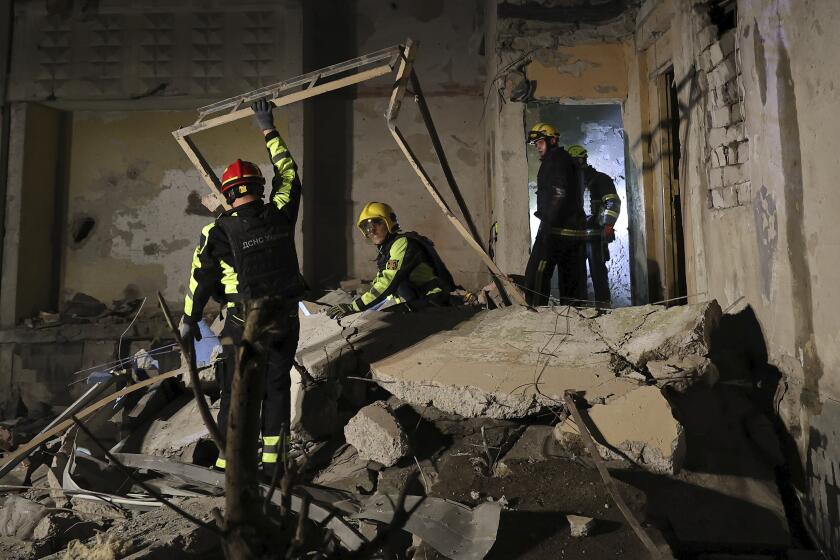Russians tackle oil-coated coast
Crews battled harsh bouts of wind and lashing rain Tuesday as they struggled to clean miles of oil-blackened coastline after a fierce weekend storm tore a petroleum tanker into pieces.
As much as 2,000 tons of oil poured into the sea Sunday, when a storm raked Russia’s eastern coast with strong wind and high waves. Environmentalists called the spill an ecological disaster and accused the government of allowing careless shipping practices.
The oil poisoned tens of thousands of birds and blackened miles of coast. People along the shore described a scene of stumbling, blinded seabirds, their feathers too matted to fly, and of a white sand beach covered with oil. Cleanup is expected to take weeks.
“You can see many birds sitting on the beach and slowly dying,” said Igor Golubenkov, a council member in the coastal town of Taman. “They don’t understand what happened to them. They try to move their wings and they no longer can. They just sit there and look at us in agony and die.”
Prime Minister Viktor Zubkov flew to the Black Sea coast Tuesday to oversee the cleanup. As he examined polluted beaches and addressed cleaning crews, Zubkov called for an investigation of the causes of this country’s latest environmental troubles, the Reuters news agency reported.
“The reason for the tragedy was inclement weather, but you probably cannot heap all of the blame on that,” he said. “We need to establish: Either this was something unavoidable, or it was tardy and inadequate action by our services, or it was the Russian habit of leaving things to chance.”
Eleven ships sank or ran aground in the storm. Three bodies have washed ashore, and five crew members were still missing in the filthy water Tuesday.
Search helicopters had been grounded by intense storms for two days.
Three of the ships that sank carried about 7 tons of sulfur to the seafloor, according to the group Environmental Watch on the North Caucasus. The ecological effect of the shipwrecks was not immediately known.
Most of the concern has centered on the fuel oil spilled by a small tanker that was anchored near an oil-chemical transfer station, where it was attempting to ride out the storm. The ship was pulled apart by the wind and waves.
The Volganeft-139, built in Bulgaria in 1978, was designed to deliver fuel oil and refined petroleum products to places that require a shallow draft. The ship had a double hull, a design being phased in as an international standard to withstand accidents.
But the aging vessel, owned by Volgotanker, a major Moscow-based oil shipping company, failed to hold up in the Strait of Kerch, a stretch of water between Russia and Ukraine known for its rough seas and high winds.
The fuel oil spread to the Taman Peninsula, which is a nature preserve.
The developing ecological disaster will raise serious questions about increasing oil shipping traffic in a protected area, said Laurence Mee, a professor of marine and coastal policy at the University of Plymouth, in Devon, England, and an expert on the Black Sea.
“What’s an old ship doing anchored in a dangerous place in front of a nature preserve?” he asked.
As hundreds of workers fanned out over 16 miles of polluted coastline Tuesday to clean up the spilled oil, tainted seaweed and oily sand, the full scope of the environmental damage was still emerging.
The wind let up, and a boat began to pump oil out of the tanks of ships that had sunk to the seabed without cracking open. By midday, crews had hauled away about 160 tons of oil, sand and polluted seaweed, said Tatyana Kobzarenko, a spokeswoman for the Emergency Situations Ministry.
Speaking by telephone from the Strait of Kerch, Kobzarenko downplayed the scope of the problem.
“We don’t agree with outcries coming from some environmental activists that this is a catastrophe,” she said. “It is an emergency situation, yes. But by no means a catastrophe.”
So far, environmentalists and local officials said, there has been little organized effort to save the poisoned birds. Golubenkov, the local council member, said that more crews with environmental expertise were needed to clean the coast and save the wildlife.
“Their numbers are insufficient, and they only concentrate on removing the oil and oil-covered seaweed,” Golubenkov said. “We are certainly strapped for cleanup equipment here and for manpower.”
Late Tuesday, Kobzarenko said that the government had decided the number of workers was insufficient. Reinforcements would arrive today, she said.
The strait is home to dolphins, and is the sole migration route for fish between the Azov and Black seas. The nearby wildlife preserve that was designated a protected area by the Russian government was also extensively polluted, local environmentalists reported.
Some depicted the oil-slicked coast as the underbelly of the oil boom that has pumped up Russia’s economy, and accused the government in Moscow of turning a blind eye to the use of ill-designed and aging vessels to carry oil.
“Now that oil prices are so high, they are ready to transport oil in anything, even in their pockets, to make money,” said Alexei Kiselev, a campaigner with Greenpeace Russia.
Times staff writer Kenneth R. Weiss in Los Angeles contributed to this report. Loiko reported from Krasnodar and Stack from Moscow.
More to Read
Sign up for Essential California
The most important California stories and recommendations in your inbox every morning.
You may occasionally receive promotional content from the Los Angeles Times.









